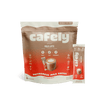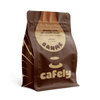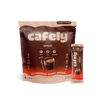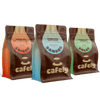Iced coffee is an excellent way to make scorching hot summer days more bearable. The most common way to make it is simply to brew your favorite coffee, leave it to cool and combine it with ice cubes and milk.
While that’s the easiest way to make iced coffee, it isn’t the best. There are countless tools that can turn a mediocre mug of iced coffee into a brilliant brew.
In this post, we’ll go over 6 different ways to make iced coffee so you can find the method that works best for you.
1. Easy Iced Coffee Recipe (Recommended)

This is the easiest way to make iced coffee at home, but you must plan ahead. You need to complete the first step at least one hour before you want to drink your coffee.
- Brew your favorite coffee however you usually do. (Our SaiGon OG Coffee is an excellent choice for a bold and buttery iced coffee.)
- Let it sit on the counter until it’s room temperature.
- Fill a glass with ice cubes and pour the cooled coffee over it.
- Customize to your taste — add milk, cream, sugar, whatever you like!
Related: Brew Guide: Vietnamese Iced Coffee
2. Pour-Over Iced Coffee

Making iced coffee with the pour-over method is a little more complicated, but it brings out coffee’s fruity and refreshing side.
If you want a balanced morning coffee with a hint of maple, we suggest our DaNang Coffee.
Brewing Steps:
- Measure your ingredients— substitute about 50% of your usual amount of water with ice to avoid a watery coffee. For a 6 oz iced coffee, you need 0.5 oz of ground coffee, 5 oz of hot water, and 2.5 oz of ice.
- Place the ice in a glass below the pour-over filter.
- Fill the filter with ground coffee.
- Swirl half the water over the ground coffee until it's saturated. Wait 30 seconds, then swirl the remaining water over the coffee.
- After the coffee brews (about two minutes), customize the drink to your taste.
Related: How to Make Top-Notch Coffee with a Hario V60 Pour-Over Device
3. Iced Drip Coffee (Automatic Coffeemaker)

The drip coffee process is similar to the pour-over method, but it’s quicker and easier. All you need is an automatic coffee machine and some ice:
- Measure your ingredients. You need to substitute 50% of the water you’d usually use with ice.
- Grind your coffee finer than you typically would and place it in the filter.
- Add the ice to the carafe and pour the water into the tank.
- Flip the switch and watch as your drip coffee machine makes the perfect iced coffee for you.
- Add extras such as milk and sugar to taste.
Related: How to Brew Coffee With a Drip Coffee Maker
4. Iced Espresso Coffee

If you have an espresso machine, you can make incredible iced coffee at home. This method can be simple or complex — it’s up to you. Our DaLat Coffee is an excellent choice for making iced coffee in an espresso machine.
If you don’t have an espresso machine, you can achieve similar results brewing the coffee with a moka pot.
Related: Brew Guide: How to Make Espresso
Simple Method
This way of making iced coffee creates a smooth, strong, and velvety drink.
- Add 1 oz of ice into a glass.
- Pull a shot of espresso into an espresso cup as you normally would.
- Pour the espresso over the ice and customize your iced coffee to taste.
Complex Method
This method makes an Italian shakerato — an ultra-cool, super-frothy, and incredibly flavorful iced coffee.
- Fill a cocktail shaker with ice.
- Add 1 oz of ice into a glass.
- Pull a shot of espresso into an espresso cup as you normally would.
- Pour the espresso into the cocktail shaker and shake until the shaker is cold on the outside. This should take around 20 seconds.
- Pour the chilled coffee into the glass with ice and customize the drink to your taste.
Related: Vietnamese Sea Salt Shakerato Coffee Recipe
5. Iced Aeropress Coffee

An Aeropress coffee maker is an excellent alternative to an espresso machine or moka pot when making iced coffee. This method is quick and gives you a balanced and vibrant coffee.
- If you’re using a paper filter, rinse it with hot water and drain. This will stop the filter from absorbing too much coffee.
- Use a ratio of 1:10 (coffee to water) to brew a coffee concentrate. Use 0.6 oz finely ground coffee and 6 oz boiling water.
- Stir the coffee and water together in the Aeropress and place the plunger on top. Leave to sit for two minutes.
- Place 3.5 oz ice in a serving glass.
- Slowly press the Aeropress plunger and stop when you hear the hiss.
- Pour the coffee concentrate over the ice, stir, and customize to your taste.
Related: How to Use an Aeropress Like a Pro
6. Iced French Press Coffee

You can make iced coffee in a French press in a very similar way to an Aeropress. This method creates a deep, bold coffee that’s perfect for drinking first thing in the morning.
- Use a ratio of 1:10 (coffee to water) to brew a coffee concentrate. Use 0.6 oz medium ground coffee and 6 oz boiling water.
- Stir the coffee and water together in the French press and place the plunger on top. Leave to sit for four minutes.
- Place 3.5 oz ice in a serving glass.
- Slowly press the plunger down until you can’t push it any further.
- Pour the coffee concentrate over the ice, stir, and customize to your taste.
Related: How to Brew the Perfect Coffee Using a French Press
What’s the Difference Between Iced Coffee & Cold Brew?
Iced coffee and cold brew coffee are two completely different things.
You make iced coffee by brewing fresh, hot coffee, which is then mixed with ice to cool it down.
In comparison, cold brew coffee is made by steeping coarse ground coffee in cold or room-temperature water for up to a day. This creates a strong coffee concentrate you can dilute with ice, water, or milk. Cold brewing creates a flavor profile that is very different from hot brewing, and the process takes longer.
Related: How to Make Vietnamese Cold-Brewed Coffee
What Coffee Beans Work Best for Iced Coffee?
The best coffee beans for iced coffee are the beans you like the most. They’ll taste a little different when you turn them into iced coffee, but the flavor profile will be pretty similar.
If you’d like to branch out from your regular coffee beans, here are some of our favorites and what they taste like when iced:
DaLat Coffee (100% Arabica)

DaLat beans are 100% arabica, which is the most common type of coffee due to its mellow and balanced flavor. It's best if you make iced coffee with a regular drip coffee maker, French press, or pour-over.
Our DaLat Coffee has a low acidity and a rounded, complex flavor, which is exactly what you’re looking for when making iced coffee. Each sip contains delicious flavors of caramel, blackberry, and stonefruit.
DaNang Coffee (50/50 Arabica/Robusta Blend)

DaNang Coffee is a mixture of arabica and robusta beans, making it a great choice if you’re looking for something a little stronger than regular arabica. They offer the best of both worlds — all the balanced flavor profile of arabica beans with the high caffeine content and strong taste of robusta.
This type of coffee is incredibly versatile and works great with a pour-over coffee maker, AeroPress, drip coffee maker, moka pot, espresso machine, and phin filter. The citrus, maple syrup, and toasted nut flavors make it ideal for iced coffee.
SaiGon OG Coffee (Traditional Butter-Roast Coffee)

SaiGon OG Coffee is our favorite type of coffee for every brewing method — and is fantastic iced. It includes a complex combination of robusta, arabica, and peaberry coffee beans, giving it a high caffeine content and balanced Vietnamese coffee flavor.
These beans work best for regular and iced Vietnamese coffee using a phin filter, but they also work for drip, espresso machines, AeroPress, and moka pots. The iced coffee will be perfectly balanced with bold, vibrant flavors.
HaNoi Coffee (100% Robusta Coffee)
Choose HaNoi beans if you’re craving a bold iced coffee. HaNoi Coffee is made with 100% robusta beans from the central highlands of Vietnam, giving it a bold, high-in-caffeine flavor profile.
While it’s best suited for making Vietnamese iced coffee with a phin filter, it also works with an espresso machine, moka pot, and drip coffee maker. The earthy, malty, chocolatey iced coffee you brew with these beans will leave you swooning.
Iced Coffee Variations
There are many ways you can jazz up iced coffee to make it more interesting. Here are some of our favorite variations:
- Milk alternatives — Try hazelnut or almond milk for a nutty twist, whole milk for an indulgently creamy texture, or coconut milk for a tropical feel.
- Flavored syrup — From vanilla and cinnamon to chocolate fudge and peppermint, there are loads of incredible-tasting flavored syrups you can add to your iced coffee.
- Cocoa powder — Turn your iced coffee into an iced mocha by stirring in a tablespoon of plain cocoa powder. If you’ve got a sweet tooth, try pre-made hot cocoa powder instead.
- Alcohol — If you need something a little stronger than regular coffee, add a shot of Bailey’s Irish Cream, Kahlua, or Disaronno Amaretto to your iced brew. For a real kick, try our recipe for a Vietnamese espresso martini.
- Whipped cream — Adding a swirl of whipped cream to the top of your iced coffee is an easy way to transform a simple drink into a delicious dessert. Add a dusting of cinnamon or even mini marshmallows for a little extra.
Troubleshooting Iced Coffee: What Went Wrong?
If your iced coffee didn’t go as planned, it could be due to one of the following reasons:
- Tastes bitter — The coffee beans are over-extracted. Try a coarser coffee grind, reduce the brewing time, brew at a lower temperature, or use less ground coffee.
- Flavor is weak — You’re using too much milk or ice. Use a higher coffee-to-water ratio when brewing or less milk/ice when preparing your drink.
- Appears cloudy — Poor filtration or presence of sediment. Use a paper or fine mesh filter to remove unwanted coffee grinds. If you’re using a French press, don’t disturb the grounds when they’ve settled.
- Ice melts too fast — Use a double-walled insulated cup, chill your glass before pouring in your iced coffee, or use bigger ice cubes.
- Stale or flat taste — The coffee beans are stale or old. Use freshly roasted coffee beans and grind them just before brewing. Store beans in an airtight container away from heat, light, and moisture
- Sour or acidic flavor — You brewed the coffee for too long or at too high a temperature. Brew for less time, brew at a lower temperature, or try different brewing methods. You could also try coffee beans with lower acidity, such as SaiGon OG.
FAQs: Iced Coffee
When you get the hang of it, iced coffee is delicious and easy to make at home. Here’s some extra info to help you become an iced coffee expert.
1. How much caffeine is in iced coffee?
The caffeine content of iced coffee depends on the beans you use, the brewing method, and the size of your drink.
Here's a chart detailing how much caffeine is in iced coffee based on the brewing methods:
|
Type of Coffee |
Caffeine Content |
Size of Cup |
Caffeine per serving |
|
Vietnamese Coffee |
33 mg/oz |
2–4 oz |
66–130 mg |
|
Espresso (Single Shot) |
75 mg/Shot |
1–2 Shots |
75–150 mg |
|
Espresso- Based Drink (e.g., Cappuccino) |
75 mg/Shot |
1–2 Shots in a 6 oz Drink |
75–150 mg |
|
Pour-Over |
12–20 mg/oz |
8 oz |
90–160 mg |
|
Cold Brew |
12–13 mg/oz |
16 oz |
197–213 mg |
|
French Press |
13–17 mg/oz |
8 oz |
100–137 mg |
|
Regular Coffee |
10–13 mg/oz |
8 oz |
80–100 mg |
|
Instant Coffee |
8–10 mg/oz |
8 oz |
80–120 mg |
|
Decaffeinated Coffee |
0–0.9 mg/oz |
8 oz |
0–7 mg |
2. Is iced coffee healthy?
Studies show that there may be many health benefits to drinking coffee, including iced coffee. Coffee is high in antioxidants and caffeine — interestingly, robusta coffee is higher in both — two things that can help your body fight off disease to stay healthy.
Here are just some of the health benefits of iced coffee:
- Increased energy levels [1]
- Lower risk of type 2 diabetes [2]
- Greater heart health [3]
- Aided weight loss [4]
- Boosted metabolism [5]
3. Is iced coffee just hot coffee with ice?
Yes, sometimes. You make some kinds of iced coffee (such as espresso) by brewing hot coffee and pouring it over ice. You make others (like regular coffee) by brewing hot coffee, waiting for it to cool, and pouring it over ice. And if you want to elevate the texture and flavor, you can add cold foam to make it creamier and more café-style.
4. How do you make blended iced coffee (frappe)?
Blended drinks are trickier to make because they easily become too diluted. The trick is to brew the coffee extra strong and have it as cold as possible before blending it.
However, the easiest option is to use instant coffee — this gives you the concentration you need and won’t water it down. Our instant Vietnamese milk coffee or coconut coffee are perfect for this, as they add the right touch of creaminess.
Making iced coffee with a blender creates an incredibly thick and frothy drink that tastes like dessert!
Try this recipe if you want to make your own frappe (one serving):
- 1 cup small ice cubes
- ½ cup strong coffee cooled* (espresso, phin filter, or moka pot works best)
- ¼ cup milk or milk alternative
- 3 tablespoons superfine sugar (adjust to taste)
- A dash of pure vanilla extract or 1-3 tablespoons of flavored coffee syrup to taste
- Whipped cream and caramel sauce for topping (optional)
* If you’re using instant coffee, simply use the amount needed to make ½ cup of coffee, but add the powder to the (cold) milk or directly into the blender.
Add all of the ingredients into a blender. Following the manufacturer's directions, blend until smooth. Often, there's a setting specifically for ice.
5. How do you make iced coffee at home without a machine?
Use instant coffee to make iced coffee at home without a machine. Add 1–2 teaspoons of instant coffee into a mug and pour over boiling water until the mug is ¾ of the way full.
Leave the coffee to cool. When it’s at room temperature, pour it over ice. You can add milk, sugar, and any extras to taste, such as coffee jelly to add a boba-like element to the brew.
References
- Justin Evans, John R. Richards, Amanda S. Battisti. (2023). Caffeine.
- Mattias Carlström, Susanna C Larsson. (2018). Coffee Consumption and Reduced Risk of Developing Type 2 Diabetes: a Systematic Review with Meta-Analysis.
- Fernando Rodríguez-Artalejo, Esther López-García. (2018). Coffee Consumption and Cardiovascular Disease: A Condensed Review of Epidemiological Evidence and Mechanisms.
- Ariel Lee, Woobin Lim, Seoyeon Kim, Hayeong Khil, Eugene Cheon, Soobin An, SungEun Hong, Dong Hoon Lee, Seok-Seong Kang, Hannah Oh, NaNa Keum, and Chung-Cheng Hsieh. (2019). Coffee Intake and Obesity: A Meta-Analysis.
- A G Dulloo, C A Geissler, T Horton, A Collins, D S Miller. (1989). Normal Caffeine Consumption: Influence on Thermogenesis and Daily Energy Expenditure in Lean and Postobese Human Volunteers.
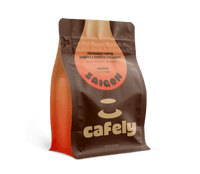
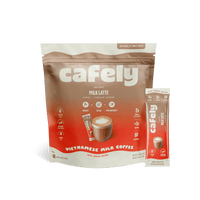
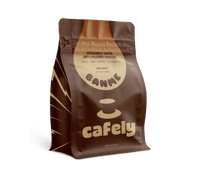
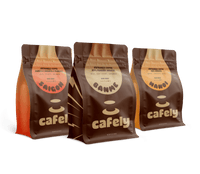
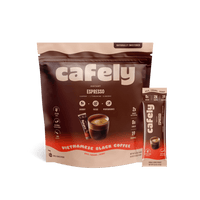
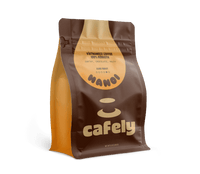




![How to Make Delicious Iced Coffee Using Instant Coffee [Quick Guide]](http://cafely.com/cdn/shop/articles/How_to_make_iced_coffee_with_instant_coffee_featured_image_67b3cf3a-33d1-42f0-ad45-e5339d3e1acf.jpg?v=1743108157&width=400)

